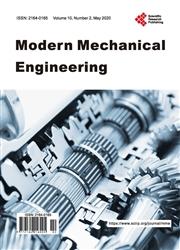Evaluating the Structural Integrity of Fibreglass for the Manufacture of Headgears
引用次数: 1
Abstract
A composite material is made up of two phases, the matrix, and the reinforcing materials. The reinforcing material is embedded over matrix material. The reinforcing material works to make the matrix material harder. A fibreglass reinforced composite was developed using E-glass fibre reinforcement and epoxy resin matrix. The composites were produced using the hand lay-up technique with varying fibre percentage of 9%, 13% and 25% by weight percentage of fibreglass mat at orientations of 0°, 15°, 45°, and 90° chosen at random. A 13% by weight percentage of chopped mat was also developed for purpose of comparison. The fabricated composites were subjected to tensile test, flexural test, impact test, punch shear test and hardness test to ascertain the appropriate fibre contents and orientation that is optimum for the manufacture of headgears. Analysis of Variance was carried out to determine level of significance and percentage contribution of the parameters. The results show that both fibre orientation and percentage of fibre content reinforcement of have significant influence on the strength and fracture energy of the composite .The fibre orientation has a higher impact on the strength of the composite (79.74%) while the percentage of fibre reinforcement has a lesser impact on the tensile strength of the composite (20.26%). However, the fibre orientation has a lesser impact on the fracture energy of the composite (24.54%) while the percentage of fibre reinforcement has a higher impact on the fracture energy of the composite (75.46%) The result from this study shows that the increase in fibre content increases flexural strength and impact toughness of the fibreglass reinforced composite. A fibre orientation of 90° and fibre reinforcement of 25% wt. was determined to be optimally suitable for the manufacture of headgears.用于制造头架的玻璃纤维结构完整性评估
复合材料由基体和增强材料两相组成。所述增强材料嵌入在基体材料之上。增强材料的作用是使基体材料更坚硬。以e型玻璃纤维为增强材料,以环氧树脂为基体,研制了一种玻璃纤维增强复合材料。复合材料采用手工铺层技术,在0°、15°、45°和90°方向随机选择不同纤维百分比的玻璃纤维垫,分别为9%、13%和25%。为了进行比较,还开发了13%重量百分比的切碎垫。通过拉伸试验、弯曲试验、冲击试验、冲剪试验和硬度试验,确定了最适合制造头套的纤维含量和取向。进行方差分析以确定参数的显著性水平和百分比贡献。结果表明:纤维取向和纤维增强率对复合材料的强度和断裂能均有显著影响,其中纤维取向对复合材料强度的影响较大(79.74%),而纤维增强率对复合材料抗拉强度的影响较小(20.26%)。然而,纤维取向对复合材料断裂能的影响较小(24.54%),而纤维增强率对复合材料断裂能的影响较大(75.46%)。研究结果表明,纤维含量的增加增加了玻璃纤维增强复合材料的抗弯强度和冲击韧性。确定纤维取向为90°,纤维增强度为25% wt的纤维最适合制造头饰。
本文章由计算机程序翻译,如有差异,请以英文原文为准。
求助全文
约1分钟内获得全文
求助全文

 求助内容:
求助内容: 应助结果提醒方式:
应助结果提醒方式:


